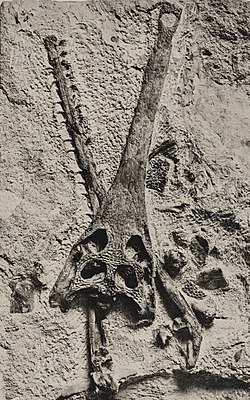Biology:Thoracosaurus
| Thoracosaurus | |
|---|---|

| |
| Thoracosaurus macrorhynchus skull and jaws from the Paleocene (Danian) of Sweden | |
| Scientific classification | |
| Domain: | Eukaryota |
| Kingdom: | Animalia |
| Phylum: | Chordata |
| Class: | Reptilia |
| Clade: | Archosauromorpha |
| Clade: | Archosauriformes |
| Order: | Crocodilia |
| Superfamily: | Gavialoidea |
| Genus: | †Thoracosaurus Leidy, 1852 |
| Species | |
Thoracosaurus is an extinct genus of long-snouted eusuchian which existed during the Late Cretaceous and Early Paleocene in North America and Europe.
Taxonomy
Thoracosaurus had traditionally been thought to be related to the modern false gharial, largely because the nasal bones contact the premaxillae. Phylogenetic work starting in the 1990s instead supported affinities within Gavialoidea exclusive of such forms,[2] although a 2018 tip dating study simultaneously using morphological, molecular (DNA sequencing), and stratigraphic (fossil age) data suggests that it might have been a non-crocodylian eusuchian.[3] The genus contains the type species Thoracosaurus neocesariensis in North America,[4] and what is either Thoracosaurus isorhynchus or Thoracosaurus macrorhynchus from Europe; a recent review[5] argues that T. macrorhynchus is a junior synonym of T. isorhynchus, but it is unclear whether the type of T. isorhynchus allows differentiation of European and North American Thoracosaurus; if not, then T. isorhynchus would be a nomen dubium. A number of species have been referred to this genus, but most are dubious.[2]
Ecology
It is thought to have inhabited marine environments.[6]
Gallery
References
- ↑ Rio, Jonathan P.; Mannion, Philip D. (6 September 2021). "Phylogenetic analysis of a new morphological dataset elucidates the evolutionary history of Crocodylia and resolves the long-standing gharial problem". PeerJ 9: e12094. doi:10.7717/peerj.12094. PMID 34567843.
- ↑ 2.0 2.1 Brochu, C. A. (2006). "Osteology and phylogenetic significance of Eosuchus minor (Marsh, 1870) new combination, a longirostrine crocodylian from the Late Paleocene of North America". Journal of Paleontology 80 (1): 162–186. doi:10.1666/0022-3360(2006)080[0162:OAPSOE2.0.CO;2].
- ↑ Michael S. Y. Lee; Adam M. Yates (2018). "Tip-dating and homoplasy: reconciling the shallow molecular divergences of modern gharials with their long fossil record". Proceedings of the Royal Society B: Biological Sciences 285 (1881): 20181071. doi:10.1098/rspb.2018.1071. PMID 30051855.
- ↑ Page 125; A study of fossil vertebrate types in the Academy of Natural Sciences of Philadelphia: taxonomic, systematic, and historical perspectives Issue 16 of Special Publication Series, Academy of Natural Sciences (Philadelphia, Pa.) By Earle E. Spamer, Edward Daeschler, L. Gay Vostreys-Shapiro. Academy of Natural Sciences, 1995 ISBN:0-910006-51-2 ISBN:978-0-910006-51-4
- ↑ Brignon, A. (2017). "The collecting of fossil vertebrates in Mont-Aimé (Marne, France) by the Baron de Ponsort (1792–1854)". Bulletin d'Information des Géologues du Bassin de Paris 54 (3): 20–44.
- ↑ Puértolas-Pascual, Eduardo; Blanco, Alejandro; Brochu, Christopher A.; Canudo, José Ignacio (January 2016). "Review of the Late Cretaceous-early Paleogene crocodylomorphs of Europe: Extinction patterns across the K-PG boundary" (in en). Cretaceous Research 57: 565–590. doi:10.1016/j.cretres.2015.08.002. https://linkinghub.elsevier.com/retrieve/pii/S0195667115300458.
Wikidata ☰ Q2408250 entry
 |


